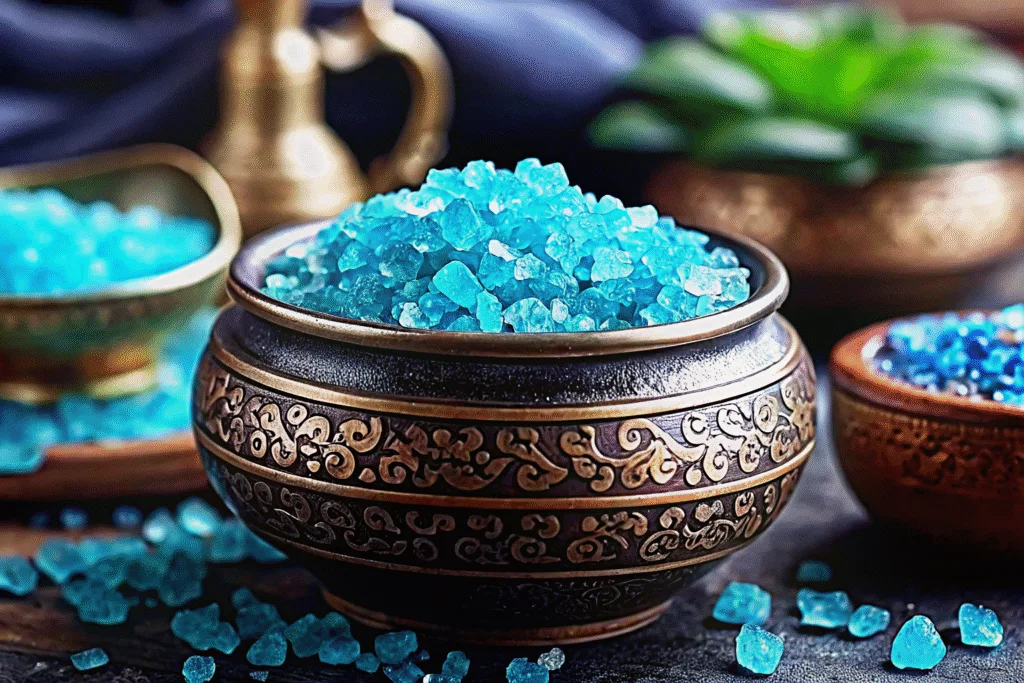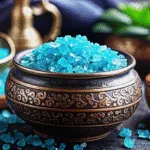
Persian blue salt is one of the rarest salts in the world. It is mined from ancient salt deposits in the Semnan province of northern Iran and owes its striking blue shimmer to sylvinite, a potassium‐rich mineral that forms under extreme pressure. Only a few tons of this mineral are harvested each year, making genuine Persian blue salt an expensive luxury. Though it has become popular on social media as the “blue salt trick” drink, it’s important to distinguish natural blue salt from dyed table salts or viral health hacks. This guide examines the real science behind blue salt, analyses the top competing recipes online, and shows you two ways to make blue salt at home—one as a hydrating drink using authentic Persian blue salt, and the other as a colourful finishing salt infused with butterfly‑pea flowers.
Table Of Contents
Table of Contents
Understanding Persian Blue Salt vs “Blue Salt Tricks”
Authentic origin. Persian blue salt comes from ancient salt ponds in the Ergourz mountain range of the Semnan province (northern Iran). The blue hue results from sylvinite—a potassium mineral present in halite salts. According to Mayi Salt’s educational article, the distinctive colour also arises from trace minerals such as calcium carbonate and potassium. Because this salt is naturally coloured and mined in limited quantities, it should not be confused with table salt dyed with food colouring.
What the viral “blue salt trick” is. Recent blog posts and social‑media videos promote dissolving a teaspoon of Persian blue salt in water with lemon and mint and drinking it as a wellness boost. While trace minerals like potassium and magnesium are indeed present in authentic blue salt, there is no clear scientific research proving that this drink improves performance or treats health conditions. Mayi Salt notes that although some people believe Persian blue salt has a lower sodium content and alkalising effects, there isn’t sufficient scientific evidence to support these claims. Therefore, enjoy the drink as a novelty hydration ritual but avoid treating it as a cure‑all.
Daily sodium limits. Regardless of salt type, sodium intake should be limited. The DASH eating plan from the U.S. National Heart, Lung and Blood Institute recommends consuming no more than 2,300 mg of sodium per day, with 1,500 mg offering additional blood‑pressure benefits. A teaspoon (5 g) of any salt contains roughly 2,300 mg of sodium—essentially the full daily allowance. So if you drink a blue‑salt beverage, limit additional salt in meals that day.
Nutrients & Benefits
Persian blue salt contains sodium chloride as its primary component, but it also holds trace minerals. According to HowToCookToday, potassium, magnesium and calcium are present. Mayi Salt similarly notes that the blue colour comes from sylvinite and that the salt contains calcium carbonate, sodium chloride and potassium. These minerals support functions such as fluid balance, nerve transmission and bone health. However, the amounts are small—most benefits come from adequate hydration, not mineral supplementation.
Equipment & Ingredients
For the blue‑salt drink (1 serving)
- Authentic Persian blue salt – ½ to 1 teaspoon (look for natural blue salt or infuse your own; avoid dyed salts)
- Filtered water or plant‑based milk – 1 cup (room temperature or chilled)
- Lemon or lime juice – a few drops (adds brightness)
- Honey or maple syrup (optional) – 1 teaspoon for sweetness
- Fresh mint leaves (optional) – 2–3 leaves for a cooling finish
- Small glass or cup, spoon or whisk, funnel and dark‑glass spray bottle if you’re making a spray
For butterfly‑pea flower finishing salt (yields ≈1 cup)
- Sea salt (coarse or flaky) – ¾ cup
- Dried butterfly‑pea flowers – 1 tablespoon
- Food processor or blender
- Air‑tight jar for storage

Blue Salt
- Total Time: 5 minutes
- Yield: 1 serving
- Diet: Vegan
Description
A refreshing and unique blue salt drink, perfect for hydration with a burst of flavor from the infusion of natural blue salt, citrus, and mint.
Ingredients
Authentic Persian blue salt – ½ to 1 teaspoon
Filtered water or plant-based milk – 1 cup (room temperature or chilled)
Lemon or lime juice – a few drops
Honey or maple syrup (optional) – 1 teaspoon
Fresh mint leaves (optional) – 2–3 leaves
For butterfly‑pea flower finishing salt (yields ≈1 cup)
Sea salt (coarse or flaky) – ¾ cup
Dried butterfly‑pea flowers – 1 tablespoon
Instructions
1. 1. Start by preparing the blue salt drink. Add ½ to 1 teaspoon of authentic Persian blue salt to a small glass or cup.
2. 2. Pour in 1 cup of filtered water or plant-based milk, at room temperature or chilled.
3. 3. Add a few drops of lemon or lime juice for brightness.
4. 4. If desired, sweeten the drink with 1 teaspoon of honey or maple syrup.
5. 5. Garnish with 2–3 fresh mint leaves for a cooling finish.
6. 6. Stir the ingredients with a spoon or whisk until the salt is dissolved and everything is mixed well.
7. 7. Serve immediately or refrigerate for later use.
Notes
For the butterfly‑pea flower finishing salt:
1. In a food processor or blender, combine ¾ cup of coarse or flaky sea salt with 1 tablespoon of dried butterfly‑pea flowers.
2. Blend until the flowers are incorporated into the salt, creating a beautiful blue-colored mixture.
3. Store the butterfly‑pea flower salt in an air-tight jar for later use.
- Prep Time: 5 minutes
- Cook Time: 0 minutes
- Category: Beverage
- Method: Mixing
- Cuisine: Persian
Recipe 1 – Authentic Blue‑Salt Drink (Blue Salt Trick)
- Choose real Persian blue salt. Ensure the salt’s blue colour comes from natural minerals such as sylvinite. Avoid table salt dyed blue.
- Dissolve the salt. Pour 1 cup of filtered water or plant‑based milk into a glass. Add ½ to 1 teaspoon of Persian blue salt and stir until it dissolves. The liquid will shift from clear to a cloudy sky‑blue.
- Add acidity. Squeeze a few drops of lemon or lime to brighten the flavour. This also masks any metallic notes.
- Enhance taste (optional). Stir in 1 teaspoon of honey or maple syrup for subtle sweetness, and drop in a few mint leaves for a cooling effect.
- Let it rest. Allow the drink to sit for 5–10 minutes so the tiny air bubbles disperse. Some bloggers bottle this mixture in a dark‑glass atomiser and refrigerate for 30 minutes; this is optional.
- Serve & enjoy. Sip slowly as part of your hydration routine. Limit yourself to one drink per day—each teaspoon of salt already meets the daily sodium allowance.
Personal tip: I like to use almond milk for a creamy morning drink and plain water post‑workout. When using water, chilling the drink makes it taste crisper. If you’re sensitive to saltiness, start with ½ teaspoon and adjust.
Recipe 2 – Butterfly‑Pea Flower Blue Salt (Finishing Salt)
This colourful finishing salt is easier to make at home than sourcing rare Persian salt. Dried butterfly‑pea flowers impart a natural blue hue and subtle earthy notes. According to Sugar & Charm’s recipe, you simply combine ¾ cup of sea salt with 1 tablespoon of dried butterfly‑pea flowers in a food processor.
- Dry the flowers. If your butterfly‑pea flowers are not completely dried, spread them on a baking sheet and bake at 250 °F (120 °C) for 15 minutes until crisp. Drying prevents clumping.
- Blend. Place ¾ cup of coarse sea salt and 1 tablespoon of dried butterfly‑pea flowers into a food processor or blender. Pulse on high for about 2 minutes until the petals are finely ground and the salt takes on a vibrant blue tint.
- Store. Transfer the blue salt to an air‑tight jar and store in a cool, dry place. It will keep for up to six months.
- Use as finishing salt. Sprinkle it over salads, avocado toast, roasted vegetables, desserts or cocktails for colour and a mild floral note. Because the salt is still mostly sodium chloride, use sparingly.
Serving, Variations & Ideas
- Citrus twist: Swap lemon with grapefruit or orange for a sweeter acidity.
- Herbal notes: Replace mint with basil or rosemary. Rosemary adds a woodsy aroma; basil pairs well with cucumber water.
- Spice it up: Add a pinch of ginger or cinnamon for warmth (especially if using plant‑based milk).
- Hydration with fruit: Add slices of cucumber or watermelon to the drink for extra refreshment.
- On food: The butterfly‑pea blue salt can be used as a decorative rim on cocktail glasses or sprinkled on eggs or desserts for a pop of colour.
Safety & Frequently Asked Questions
Can I use regular table salt instead of Persian blue salt?
You could make a similar‑looking drink by dyeing table salt, but it will not contain the trace minerals or unique flavour of real Persian blue salt. Also, many dyed salts use artificial colouring. If you cannot find authentic blue salt, consider making the butterfly‑pea flower finishing salt instead.
Is it safe to drink blue‑salt water every day?
For healthy adults, consuming a small glass of blue‑salt water occasionally is unlikely to cause harm. However, because one teaspoon of salt contains approximately 2,300 mg of sodium—the upper daily limit for adults—drinking it daily can contribute to high sodium intake. Mayi Salt emphasises that there is no clear scientific research supporting specific health benefits of Persian blue salt. People with high blood pressure, kidney disease or other chronic conditions should consult a healthcare professional before trying it.
Does Persian blue salt taste different?
The flavour is similar to high‑quality sea salt but slightly less salty and more complex. HowToCookToday notes that the mineral composition of Persian blue salt gives it a crisp, clean taste with trace minerals like potassium and magnesiumhowtocooktoday.com. The butterfly‑pea infused salt has a mild earthy floral note.
Is the blue colour natural?
Yes, in authentic Persian blue salt the colour comes from the mineral sylvinite. In the butterfly‑pea salt it comes from anthocyanins in the flowers. Avoid products with artificial dyes.
Can children drink blue‑salt water?
Because children require much less sodium than adults, it’s best to avoid giving them salt‑based drinks. DolceRecipe advises checking with a paediatrician before allowing kids to consume such drinks.
Where can I buy Persian blue salt?
It’s sold in specialty spice shops or online gourmet retailers. Mayi Salt cautions that many “blue salts” on the market are dyed or imitation; always look for products labelled as authentic and sourced from Iran.
Conclusion
Blue salt is captivating both for its natural colour and the viral recipes it inspires. Genuine Persian blue salt forms in ancient Iranian salt deposits and owes its hue to the potassium mineral sylvinite. While it contains trace minerals that contribute to its flavour, there is no scientific evidence that drinking blue‑salt water provides extraordinary health benefits. Salt—whatever its colour—still delivers the same sodium load, so moderate intake is essential. For a fun culinary experiment, try making the blue‑salt drink as an occasional hydration ritual, or create butterfly‑pea flower finishing salt to elevate your dishes. By understanding the science and consuming responsibly, you’ll enjoy the beauty of blue salt while maintaining a heart‑healthy diet.
